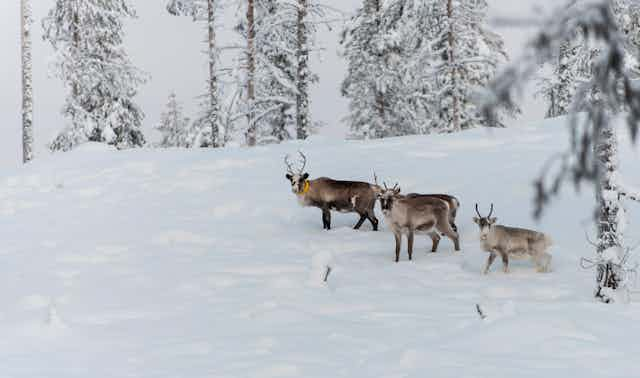Half of the planet’s non-human species are already on the move in response to climate change impacts on temperature, precipitation or the movement of other species. Some do well in their new locations, but others are threatened by the shifts because of a lack of food or a mismatch in the timing of pollinators, for example.
Traditional forms of species conservation have focused on well-defined, immovable boundaries to create national parks or other protected areas, which often exclude people from living within them. But this approach may do more harm than good.
Not only does it neglect the ways climate change will continue to shift species ranges well into the future, it ignores the millions of people who are migrating alongside other species, sometimes because they have no other place to go and sometimes because their livelihoods and cultures depend on coexistence.
As the challenges posed by a planet on the move come into focus, scientists, policy-makers and communities are trying alternative approaches to conservation.
Our new study argues that conservation must facilitate just and effective responses to climate-induced displacement. For this, conservation needs not only to draw on climate science to anticipate and adapt to migrations. It also has to integrate approaches that respect human rights, promote the coexistence of humans and wildlife and reduce tensions between local communities, migrant populations and conservation authorities.
Human displacement and conservation anxieties
Non-human species aren’t the only ones relocating. An estimated 1.2 billion people are at risk of displacement by 2050 due to extreme weather, sea level rise and other environmental threats. About a quarter of humanity currently lives in conflict-affected areas, and tens of millions of people are displaced annually due to wars, violence and human rights abuses.
Some seek refuge in protected areas. This has happened after Russia’s invasion of Ukraine, as well as following conflicts in Afghanistan, the Democratic Republic of Congo and Syria.
Read more: Refugee camps can wreak enormous environmental damages – should source countries be liable for them?
These human migrations could threaten other species, escalate health threats or lead to violent human-animal conflicts, but the evidence so far remains inconclusive.
In anticipation of climate change and displacement, powerful voices in the conservation community, such as E.O. Wilson and the World Wildlife Fund (WWF), have promoted tripling area-based environmental protection under slogans like “nature needs half,” a new international biodiversity target aims to conserve at least 30 per cent of planet by 2030.
Several studies, however, conclude that the Half-Earth Project and similar campaigns could affect the rights, livelihoods and cultures of more than one billion people, mostly Indigenous and traditional communities. Reports, like the “Cornered by Protected Areas” series and public backlash to WWF’s alleged involvement in human rights abuses in protected areas in Africa and Asia, supplement decades of evidence that conservation can be violently disruptive to people and their well-being.

Displacement can also generate human–wildlife conflicts. For example, the settlement of 860,000 Rohingya from Myanmar in refugee camps in Cox’s Bazar, Bangladesh, put them right along an elephant migration corridor, trapping 38 elephants in a forest fragment at the edge of the camps.
Between 2017 and 2018, more than a dozen people were trampled by elephants trying to migrate, and more than a dozen elephants were killed between 2018 and 2020.
Rethinking conservation and displacement
As climate change intensifies, the conservation community must undertake a deeper analysis of multi-species mobility, promote a more inclusive dialogue with those who are affected by climate change and the movement of non-human species, and avoid the displacement of people. Here are four ways to rethink conservation:

Mobile protected areas have boundaries that shift in space and time in anticipation of future changes or in response to species displacement. The concept originated with marine protected areas and is now being explored with land-based protected areas. Mobile protected areas require dynamic management, making them challenging to develop under rigid bureaucracies and across international borders. They may also focus on obvious mobile species such as migratory megafauna and neglect the adaptive needs of other species.
Wildlife corridors and other connectivity conservation measures reconnect fragmented habitats to protect migratory species, reduce inbreeding and maintain natural processes, such as grazing and pollination. Initiatives like Yellowstone to Yukon integrate non-human population movements as a foundational principle. Regional initiatives, like the Mesoamerican Biological Corridor, exemplify how environmentally focused migratory pathways do not have to expand protected areas. Rather, these can be formed by biodiversity-friendly land uses and wildlife bridges, including across highways. However, this patchwork of conservation initiatives and associated organizations can be difficult to manage.
Indigenous and community conserved areas, or Territories of Life, are culturally based, self-governing systems that secure the well-being of communities and their environments, where human and non-human species live together. Unfortunately, for lack of funding or government support, community-based approaches often remain vulnerable to takeovers by extractive industries, agricultural expansion, large-scale infrastructure and exclusionary forms of conservation.
Ex situ conservation protects species outside their natural habitats. Zoos are the best-known form, but plant species have also been aggressively extracted from their places of origin and secured in seed banks, like the Svalbard Global Seed Vault. Researchers are also banking eggs, sperm, embryos and other tissues of threatened species in so-called frozen zoos, using cryopreservation. Various forms of ex-situ conservation have in effect created “other places” for species to move to, raising ethical questions about which species are preserved, who controls and can access them and where they will end up.
The conservation challenges of climate-induced migration are massive and require multiple forms of responses. Each one poses specific human rights and well-being risks and opportunities. By prioritizing solutions with positive social impacts, conservation will not only be just, but also more effective through greater public support.
Galeo Saintz, the founding chair of the World Trails Network, co-authored this article.

